My review of the film Murder at Glen Athol not too long ago mentioned that it was based on a Doubleday Crime Club mystery of the same title, a book written by Norman Lippincott. It turns out that this is the only work of detective fiction that Lippincott wrote, and that otherwise he was more or less a man of mystery.
Here’s his current listing in Crime Fiction IV, by Allen J. Hubin:
* * Murder at Glen Athol (Doubleday, 1935, hc) [Pennsylvania] World’s Work, 1935. Film: Invincible, 1935; also released as Criminal Within (scw: John W. Krafft; dir: Frank R. Strayer).
I’d love to be able to show you a cover scan of the dust jacket, but none of my usual sources seems to have one. No one on the Internet even seems to have a copy for sale, as I indicated before, either with or without a dust jacket.
A few days ago Victor Berch sent me a couple of emails about Norman Lippincott, telling me everything he’d been able to discover about him, which was considerable. I’ve combined the two messages into one, as follows:
Over the past weekend, I spent some time looking for Norman Lippincott, author of Murder at Glen Athol. I had a bit of luck in tracking him down in a roundabout way.
First, I found an obituary for his son, Franklyn M. Lippincott, who died rather young in New York City in 1941. The son was described as an editor of Screen Fun and other magazines, plus he was identified as the son of Norman Lippincott, the writer. So I knew I was on the
right track.
Franklyn’s age at the time of his death was given as 46, so he must have been born ca. 1895. This meant that I could possibly track him (and his father) through the 1900, 1910, 1920 census records, which I proceeded to do.
The 1900 Census found Franklyn (sometimes spelled Franklin) and his father, Norman R. Lippincott living in Bellevue, PA. His father’s (Norman’s) occupation was listed as a salesman for a cash register company.
I next figured that Franklyn would have been just about the right age to be drafted into the US Army during WW I, but he didn’t show up at all. That could be due to the fact that he had already enlisted in some branch of the service.
But, much to my surprise, his father’s (Norman R. Lippincott) showed up. His full name was given as Norman Roger Lippincott, born December 23 of 1870 in Pennsylvania. His occupation at the time was a salesman for the Burroughs Adding Machine Co. in Pittsburgh, PA.
I could not establish a death date for Norman R. Lippincott. It leads me to believe that he died before 1964 and would hardly be in the Social Security records, since that information kicks in about that time. The Norman Lippincott who died in 1982 [as tentatively identified in CFIV] was Norman William Lippincott, born 1894.
Whatever Norman Lippincott may have written otherwise is probably buried in some magazines or newspapers that have not been indexed as yet. Or, had the fame of his book being made into a motion picture been enough to describe him as “Norman Lippincott, the writer”?
Victor
Al Hubin will correct the vital stats for Mr. Lippincott in the next installment of his Addenda to the Revised CFIV. Since the book itself is missing and still at large, I thought I’d supply instead the blurb for the book from the inside dust jacket flap, as provided by Ellen Nehr’s Doubleday Crime Club Companion: 1928-1991. It’s not possible to say from this, but the book sounds much more serious than the movie. My opinion of the film was that even with a noticeably lighter tone, it’s one of the better detective stories on film made around the same time and on the same budget.
Leading character: Holt (no other name)
Setting: Small western Pennsylvania town
Subject: Interfamily animosity.
Blurb: The Randels of Glen Athol were a strange clan, a group of people torn by inner stress and hatred. The focal point of their trouble was the ruthless, predatory Muriel Randel, a woman with a distorted and warped nature. Within her were those traits which must inevitably lead to an outbreak of violence in the family – an outbreak of sudden death which comes to an end only when Holt penetrates behind the veil of false clues unconsciously planted to deceive him.
After that grotesque dinner party when the two murdered bodies were discovered, it was obvious to Holt that it was an inside job, but he found a family united against him – a family which hindered rather than helped the investigation.
In the end he overcame even their opposition and was able to determine why a beautiful wanton has been murdered because a man had carelessly hung his coat on an accessible nail, and to explain what the selection of a Boston debutante’s gown had to do with the murder of a man and woman in western Pennsylvania.
Tue 17 Apr 2007
Review: DANA CHAMBERS – Rope for an Ape.
Posted by Steve under Authors , Crime Fiction IV , ReviewsNo Comments
DANA CHAMBERS – Rope for an Ape
Jonathan Press Mystery J63; digest-sized paperback; no date stated, but circa 1951. Hardcover edition: The Dial Press, 1947. Previous paperback edition: Bestseller Mystery B-103; abridged; no date stated, but circa 1948.
Jonathan Press and Bestseller Mysteries were each published by the same company, which was essentially Mercury Press, with Lawrence E. Spivak the actual publisher. Back in the 1940s Mercury Press also published Ellery Queen’s Mystery Magazine, to set a frame of reference, perhaps. I have no idea why this particular book by Dana Chambers was so popular that they did it twice. The books they reprinted are not considered very collectible, since more often than not, many of them were abridged. In this case I read the uncondensed version, and I’m sure I’m far better off for having done so.
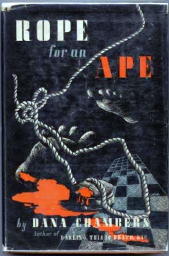
Since Dana Chambers is all but a brand new author for me, you’ll have to indulge me. Let me check in with Al Hubin’s Crime Fiction IV to see what other mysteries he might have written:
CHAMBERS, DANA; pseudonym of Albert Leffingwell, (1895-1966); other pseudonym Giles Jackson
* Too Like the Lightning (n.) Dial 1939 [Jim Steele; New York City, NY]
* She’ll Be Dead by Morning (n.) Dial 1940 [Jim Steele; New York City, NY]
* The Blonde Died First (n.) Dial 1941 [Jim Steele; Ship]
* The Frightened Man (n.) Dial 1942 [Jim Steele; New York City, NY]
* The Last Secret (n.) Dial 1943 [Jim Steele; New York City, NY]
* Darling, This Is Death (n.) Dial 1945 [Miami, FL]
* The Case of Caroline Animus (n.) Dial 1946 [Jim Steele; Miami, FL]
* Death Against Venus (n.) Dial 1946 [New York]
* Rope for an Ape (n.) Dial 1947 [New York]
—
** Dear, Dead Woman (n.) Jonathan Press 1948; See: The Case of Caroline Animus (Dial 1946).
** Too Like the Dead (n.) Bestseller 1951; See: Too Like the Lightning (Dial 1939).
** Blood on the Blonde (n.) Jonathan Press 1952; See: Witch’s Moon (Dial 1941), as by Giles Jackson.
LEFFINGWELL, ALBERT (1895-1946); see pseudonyms Dana Chambers & Giles Jackson
JACKSON, GILES; pseudonym of Albert Leffingwell, (1895-1946); other pseudonym Dana Chambers
* Court of Shadows (n.) Dial 1943 [Nile Boyd; New York City, NY]
There’s a year of death discrepancy there, I see, but I suspect that 1966 is the one that’s wrong, and that it was really 1946 when he died. If so, that would mean both that Leffingwell died young and that the book in hand was published posthumously. If and when I learn more, I’ll let you know.
While I have some of the books listed above, I’m almost positive that Rope for an Ape is the first one of them I’ve read. As for who Jim Steele was, I admit I have to cheat and tell you what Bill Crider had to say about him on his blog, where he recently reviewed The Blonde Died First:
Steele is a series character, and this isn’t his first appearance. I gather that he was a pretty successful spy at one time since he has the Medal of Honor. But in this one, he’s just a guy trying to solve a couple of murders, including that of the blonde of the title. (The title, by the way, is a clue.) Most of the book takes place on a cruise ship, and there’s quite a bit of action, a complicated plot, and Steele’s smooth narration to carry you along. Things get really kinky by the end of the book, surprisingly so, I thought, for a novel published in the 40s, but maybe I’m just naive. I have a couple of other books by Dana Chambers, and I guess it’s time I read them.
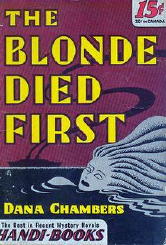
So Jim Steele is a radio writer, is he? Then what’s he doing being listed on Kevin Burton Smith’s master list of private detectives on his Thrilling Detective website? Acting like a PI in all his stories, as a wild and probably not-so-far-off-the-mark guess.
Jim Steele’s not in this one. Suffice it to say for now that the detective of record is a fellow named Nile Boyd, he has a girl friend named Anna Warriner, and I’ll say more about both of them more in a minute. First, though, what caught my eye was a short sentence on page 65 of this edition to the effect that he and Anne were involved in a case very much like this one “up in Connecticut a while back.” Aha! Here’s a series character appearance that Al Hubin didn’t know about before – see the pair of books written by Chambers as by Giles Jackson listed up there not too long ago.
Boyd works for the New York Clarion, and now that the war has ended, he’s back from overseas as a war correspondent. Anne, who works for the same newspaper, is nearly twenty years younger than he, and since he’s now on the East Coast and she’s in California visiting her mother, and maybe having a good time out there as well, he’s beginning to worry about how strong the attraction he has on her may actually be.
He needn’t worry too much, only just a little, as it turns out. As far as the detective puzzle is concerned, the one that Boyd soon finds himself in the middle of, this is one of those wealthy “upper crust affairs” that are the equivalent of the British manor house mysteries that were so common back in the 1920s, 30s and 40s. A well-to-do family is hosting a slew of guests over a long weekend, the only problem being that some of them starting to turn up dead.
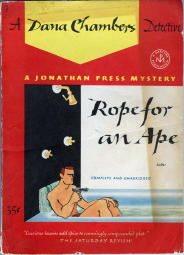
The chief suspect, and a huge negative as far as I was concerned, is a giant ape who has recently escaped from a circus train which derailed nearby. Forget that. I’ve heard too many bad radio shows and watched too many equally bad B-movies that’ve been based on this same old plot gimmick, which was tired and worn out even the first time.
But the killer is all too human, as it turns out, and it takes all of Nile Boyd’s ingenuity to nab him. And all the while he’s doing so, with Anne’s assistance eventually, there is plenty of witty upscale dialogue to keep the reader amused on a fulltime basis – at least this one was – and as usual in novels like this, particularly in the beginning, everyone is drunk, was drunk or is about to get drunk. Well, yes, perhaps I am exaggerating, but maybe that’s because I am getting a little high on the fumes myself. (Never touch the stuff otherwise.)
The case eventually turns to the tough, though, what with guns and blows to the head (Boyd’s) and a small amount of generally restrained violence such as that. After the second murder, it begins to dawn on everyone that they’re not playing fun and games any more. Nonetheless, this is a fairly-clued detective puzzle, with a long explanation at the end, with all of usual trappings.
Something for everyone, you might say. An unusual mix, and maybe the book suffers a little for it, but if you ever come across a used copy and want my advice, I think you might take at least a second scan through it before saying Yay or Nay.
[UPDATE] 04-18-07. S. B. has asked me about the cover of the paperback edition. “Is that what I think I see?” Yes, indeed. If you think you see a man sitting in a bathtub with a gun in his hand, that it is exactly what it is. Is the scene in the book? Yes, indeed again. What you see is what you get.
[UPDATE] Later on 04-18-07. I’ve just received a pair of email messages from Victor Berch, who says in the first one:
Just read your piece on Leffingwell. His middle name was Fear, which was his mother’s maiden name. He was born in Cambridge, MA, so I could check the Mass. Vital Statistics. On his draft card,the transcribers have transcribed his middle name as Fern, but looking at the actual handwriting, it is definitely Fear that is handwritten.
Victor
The second is a copy of Leffingwell’s obituary notice taken from The New York Times for August 15, 1946, so the year of death stated for him as Dana Chambers is the one that’s wrong, as suspected. Leffingwell, aged 51, was a former advertising executive who lived in Scarsdale NY at the time of his death, which occurred after a few months’ illness. He founded his own advertising agency, Olmstead, Perrin & Leffinwell, in 1925, the Times goes on to say, before turning to writing. It isn’t clear from the obituary whether he was ever a writer on a full-time basis or not.
Tue 17 Apr 2007
Obituary: RACHEL KIMOR-PAINE (1952-2007).
Posted by Steve under Authors , Obituaries / Deaths Noted1 Comment
On page 11 of the June 8-14, 2006, online edition of the Canadian newspaper The Express is a bittersweet article about author Rachel Kimor-Paine and the release of her first mystery novel, Death Under Glass, published by Killick Press. Between the time she finished the manuscript and the book itself was delivered to her door, she was diagnosed with lung cancer.
And on February 1st of this year, as reported by The Gumshoe Site earlier this month, Ms. Kimor-Paine lost her two-year battle with the disease. She was 55. The manuscript of a second book in the series, Death in the Tai Chi Retreat, is said to be in the hands of her publisher.
Death Under Glass introduces as a series character Olga Erdos, a retired lawyer from Budapest now living in St. John’s, Newfoundland. The murder of a high society woman (and real estate agent) who is poisoned with pesticide is the first of several deaths and suspicious accidents that she must solve.
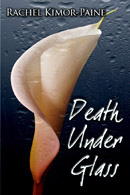
The following is excerpted from the short biography of her as posted on her publisher’s website:
A longer tribute to Rachel Kimor-Paine, including much more information about her very interesting life, can be found in the online edition of The Globe and Mail.
Mon 16 Apr 2007
Movie Review: MEET BOSTON BLACKIE (1941).
Posted by Steve under Mystery movies , Reviews[2] Comments
MEET BOSTON BLACKIE. Columbia, 1941. Chester Morris, Rochelle Hudson, Richard Lane, Charles Wagenheim, Constance Worth. Screenplay: Jay Dratler; based on a character created by Jack Boyle. Director: Robert Florey.
I was warned by Vince Keenan that in spite of their popularity at the time — there were 14 of these Boston Blackie films with Chester Morris in all — they (um) weren’t very good, or certainly not as good as he’d expected. He taped a few of them last month from TCM, just as I did, only he got around to watching some of them before I did.
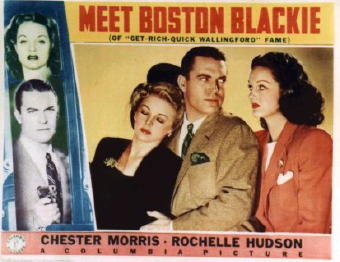
This is the first one, as you might have guessed from the title — the series lasting until 1949 — and even before I started watching it, I was convinced that Vince was wrong. And for the first 10 or 15 minutes or so, I was even more convinced. After that, well, I’ll get back to it, but Vince — crossing my fingers where you cannot see them as I say this — I’ll never doubt you again.
In this movie, it isn’t made clear whether Blackie is a reformed jewel thief or a very tricky one whom the persistent Inspector Faraday (Richard Lane) simply hasn’t been able to catch yet. They are on friendly enough terms, but Faraday has this obsession about finally outwitting his (much) more quick-witted nemesis, and he can’t quite do it.
A body found in Blackie’s cabin on a ship returning from Europe gets the chase started, and to clear himself, Blackie has to nab a gang of foreign agents hanging around a Coney Island carnival. The black-and-white atmospherics are nicely done, and then done again, until finally overdone. Another location would have been welcome, but it’s not difficult to figure out that a lot of money, time and effort had already been spent on this one.

Chased by the aforementioned gang, Blackie commandeers a roadster driven by a dark-haired beauty named Cecelia Bradley (Rochelle Hudson), whose charms Blackie doesn’t seem to recognize as quickly as the audience does — speaking only for myself, of course — but charms nonetheless.
Running the car up into a freight train to escape doesn’t work as well as planned, but after a desperate automobile chase and dodging a few bullets, the pair finally manage to get away. Miss Bradley, no weak-kneed spinster lady she, discovers that she has had the time of her life, and signs herself up with Blackie to solve the case together. While her company is certainly welcome, in my heart of hearts, I am not entirely persuaded.

I see that I am on the verge of revealing more of the plot than I should, and I had better watch what I say from here on out, except to say that the story line goes drastically downhill from here.
The light-hearted approach is a little too light-hearted. The funny lines are tired, worn and generally not very funny, even (I would have thought) for 1941 audiences. The gang of agents couldn’t smuggle their way out of wet paper bags. And for most of their time together, Blackie seems to connect with Miss Bradley on a buddy-buddy basis more than he does on a man-to-woman basis
On the other hand, Miss Bradley is definitely smitten, but as for the hint at movie’s end that she’d be coming back to appear in Blackie’s next exploit, well, it never happened. Too bad. While I’m sure Blackie will find plenty of women to pair up with through the course of his follow-up adventures, too bad indeed.
Screenwriter Jay Dratler was later nominated for an Oscar (for the movie Laura) and won a Edgar in 1949 as one of the people responsible for Call Northside 777. He was still in the minor leagues, though, when he was assigned this one to work on.
[UPDATE] 04-17-07. Looking at this blog entry this evening, checking for errors and tweaking the prose a little, neither of which I actually did, it occurred to me that none of the images I’ve posted actually came from this particular movie, not even the one in the poster. The two women in the film never met, not once.
And as long as I’m doing this update and to remain fair and balanced in my presentation, why don’t I give equal time to someone who liked the movie? Leonard Maltin gives it three stars (***) and goes on to say, “… a slick and fast-paced mystery comedy … Franz Planer’s stylish cinematography enhances this solid programmer.”
Sun 15 Apr 2007
RICHARD BURKE – The Frightened Pigeon
Unicorn Mystery Book Club; hardcover reprint, June 1946. First Edition: G. P. Putnam’s Sons, 1944. Paperback reprint: Dell 204, mapback edition, 1947.
When Victor Berch, Bill Pronzini and I did our annotated bibliography of the Ziff Davis line of Fingerprint Mysteries , we included a short profile of Richard Burke, which of course you should go read. Many of his books, we said, involved a Broadway private detective named Quinny Hite, but as it happens, this is not one of them. In fact The Frightened Pigeon takes the reader to another part of the world and (one imagines) another kind of mystery altogether.
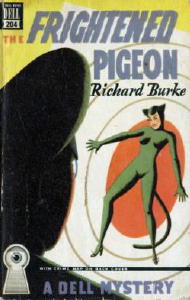
But first a word on the cover that’s shown, though, before getting down to details. This is, of course, the Dell mapback edition that’s mentioned above, and in case you can’t make out the details, the map on the back below is that of the city of Marseilles, which is where the last eighty percent of the story takes place.
The setting of the first fifty pages is Paris, 1942, with the Germans solidly in control of the city. An American dancer named Valerie Bright is still there, however — the pigeon of the title –- and very determined to stay non-political. From page 8, of the Unicorn edition:
Her close male friend, Charles John Dillon, nicknamed “Ching,” is working closely with the French underground, however, and events, beginning with a stolen German diary, bound to be embarrassing if it falls into the wrong hands — as, for example, into Ching’s hands — soon make the light-hearted Val realize how dirty — and dangerous — war really is, not knowing what will happen next nor whom your friends really are. By page 40, she is one frightened pigeon indeed, as off to Marseilles they and a small group of displaced others go, hoping to find a way out of France and its closed borders.
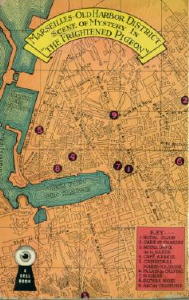
The diary appears and disappears with amazing regularity. It is, in fact, amazing, how much mileage an author (Burke) can make of one small important object. Otherwise here is a novel one can learn a large amount from — supposing, that is, that one has never been in a place controlled by Nazi-like enemies one is trying his or her best to avoid — both in term of locale (well-described) and people, especially those like Valerie, whose mind is soon brought down to earth in satisfying (but not very surprising) fashion, but also the large number of others who find themselves caught up in events far beyond their say.
Don’t get me wrong. This is by no means a major work. It’s no more than ordinary at best, in the overall scheme of things, but what it does have is atmosphere, and plenty of it.
Sat 14 Apr 2007
Western movie review: PRAIRIE LAW (1940).
Posted by Steve under Reviews , Western movies[2] Comments
PRAIRIE LAW. RKO Radio Pictures, 1940. George O’Brien, Virginia Vale, Slim Whitaker, Paul Everton, Cy Kendall. Directed by David Howard.
Generally speaking, I didn’t intend to include reviews of B-western movies here on the M*F blog, but since there’s more than the usual amount of criminous activities going on in this film’s 60 minutes, I decided to break my own rule, and who better?
A crooked land promoter, Judge Ben Curry (Paul Everton), is taking money from farmers hand over fist, without telling them two things: One, that the former ghost town of Olympia City, where his headquarters are, has no water, and two, that the land he is selling them belongs to cattleman Brill Austin (George O’Brien).
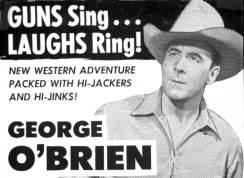
Yes, in this movie it is the cattlemen who are the good guys and not the usual other way around. Among the settlers is the daughter of one of the farmers, Priscilla Brambull (Virginia Vale) – and no, I didn’t think of that until right now, and no, it’s not that kind of movie. Among other legal misbehavior committed by Judge Curry is his blatant attempt to call for an election without proper notice, stuffing the ballot box, and declaring Olympia City the county seat so that the killer of the sheriff, Brill Austin’s Uncle Jim, can be set free.
Later on in the movie while a valid trial is being held in Prairie Rose, the jury does double duty: while deliberating on the verdict, they’re also dodging bullets by the judge’s henchmen. All this in sixty minutes, I remind you, which also includes a song sung by the uncredited Ray Whitley and his band.
There’s nothing here to be taken too seriously, as the players certainly don’t, but other than that, it’s a rather pleasurable experience. As for George O’Brien, a former silent film star who went into non-series westerns like this one when talkies came in, this was close to the end of his steady movie career.
[Truth in advertising: The photo of O’Brien comes from another film of the same vintage and not this one — but it could have been.]
Sat 14 Apr 2007
Dear Steve,
Someone sent me your review of my long lost book Dreamboat. I write to say that you are correct that the Flippo series is packed up and put away, and that I remain at the Dallas Morning News as a reporter and editor. You were too kind to Dreamboat, I thought. I wrote it in a tremendous hurry, and never liked it. But thanks, anyway.
Writing crime novels started out as a hobby, then became a part-time job, then a burden. The books weren’t making enough money for me to quit my newspaper gig, and after number five all the pleasure had drained away. So I stopped writing for a few years.
About a year ago I started writing again, but once again as a leisure-time activity. The new book is a one-off suspense that bears little resemblance to the previous five. Don’t know if I’ll ever finish it..
It was a fun ride for a while, but you’re right: it didn’t last long. Long enough, though. I had a good time while it lasted.
Doug Swanson
>> Thanks for writing, Doug, and best wishes in return on getting that new novel finished! — Steve
Sat 14 Apr 2007
Review by Mary Reed: R. AUSTIN FREEMAN – The Jacob Street Mystery.
Posted by Steve under ReviewsNo Comments
R. AUSTIN FREEMAN – The Jacob Street Mystery.
Hodder & Stoughton, 1942. US title: The Unconscious Witness; Dodd Mead, 1942. US paperback: Avon #122, 1947.
As Tom Pedley is painting in Gravel Pit Woods, concealed by shrubbery from the casual glance, he observes a woman whose odd behaviour shows she is eavesdropping on a pair of men who have just walked past. One man returns and is furtively followed by the woman, and the intrigued Pedley checks the other end of the path but sees no sign of the second man.
A week later, the artist, who has no wireless and does not read the papers, learns a murder by forcible administration of poison was committed in the wood during the very time he was painting the sylvan scene, and from a description circulated in print and on the airwaves he is obviously the man being sought for interview by the police.
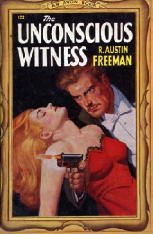
Around this time Pedley makes the acquaintance of brassy Mrs Schiller, a modernist artist separated from her husband and now living next door to Pedley. There is also Mr William Vanderpuye, who meets Mrs Schiller when he visits Pedley’s studio to arrange for a portrait sitting. The pair strike up a close friendship and Mr Vanderpuye is the last person seen with her before her disappearance. For while a dead woman is found locked in Mrs Schiller’s room with the key on the inside, she is not its tenant.
We now leap forward a couple of years. Mrs Schiller is still missing, and Freeman’s most frequently used detective character Dr Thorndyke and his assistant Dr Jervis become involved in the case due to a large bequest which would be hers if she was still alive. A presumption of death has been requested but the solicitor feels uneasy under the odd circumstances. Is she still living, and if she is, why has she not been found despite sterling efforts by the authorities and a vast amount of publicity in the press? Who was the woman found dead in her room and what is the connection between them?
My verdict: Readers will learn yet another way to open a door locked from the inside. The method in this case needs a particular type of key, common at the time, so fair enough, and its use helps point up the fact that, despite appearances, the dead woman found in Mrs Schiller’s room was not a suicide.
There are sufficient and fair clues, and the investigations are described in lively fashion. It turns out to be a more complicated case than it seems at first glance. I guessed part of the solution but not the whole. All in all I found this, the final mystery novel Freeman wrote before his death in 1943, one of the better Thorndyke outings.
Etext: http://gutenberg.net.au/ebooks05/0500481.txt
[UPDATE] Later the same evening, excerpted from an email from Mary, after she’d seen her review online:
Dear Steve
It looks very good. The cover is certainly eye-catching!
I suspect the illustrator’s artistic license had been recently renewed and was operating at its highest level! A pistol shot is mentioned at one point but there is no gunplay of the kind depicted on this cover.
The woman looks as if she has fainted but it may be a clever bit of word play since we can take it she is intended to represent the dead woman. This is because the latter could be said to have acted as an unconscious (in the sense of unknowing) posthumous witness to her own murder due to certain evidence her remains provide.
On the other hand, the publisher may have simply got the cover details mixed up…
Mary R
Fri 13 Apr 2007
Obituary: JILL McGOWN (1947-2007).
Posted by Steve under Authors , Crime Fiction IV , Obituaries / Deaths Noted[12] Comments
Jill McGown, best known as the author of a series of thirteen British police procedurals starring Chief Inspector Lloyd and Sergeant Judy Hill (later also Chief Inspector, and Lloyd’s wife) died last Friday, April 6th, after a long illness. This according to a statement recently posted on her website.
She was 59 at the time of her death.
Also on the website is a lengthy autobiography, where among many photos and details about growing up in Campbeltown, Argyll, Scotland, she says: “Campbeltown is on the Mull of Kintyre, made famous by Paul McCartney and Wings, and I knew the piper who plays the solo on the record, so there!”
Also of interest, she says in passing: “From junior school, I went to Corby Grammar School, where I was taught Latin by Colin Dexter who went on to write the Morse books, though I didn’t know that when I wrote my first book.”
Her detective stories bridge the gap between the meticulously plotted stories of the 1930s and 1940s Golden Age of mysteries, and the psychological crime stories of the 1950s, suggests one source. Not only do Ms. McGown’s series characters, Lloyd and Judy Hill solve the most deviously twisted crimes together, but they’re also lovers, their slow-moving romance part of the reason readers kept returning for the next installment.
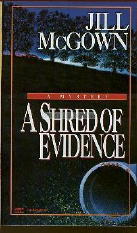
Excerpted from an online interview with Jill McGown:
I start with a character, almost always. I then rummage in my mental plot drawer for a plot that might fit this character. My ‘plots’, if you can call them that, are minimalist to say the least, so that bit isn’t difficult. With Redemption, for instance, it was simply a joke someone told me.
The character of the vicar came into my mind one night, complete with a daughter who had an abusive husband. I thought about the vicar and his family for a little while, and then saw how they could fit my ‘joke’ plot.
The complexity comes as I write, and is dictated by the characters as they are revealed to me. The plot will always give way to the characters, so even I don’t always know how the story will end.
The title usually emerges during the writing, but sometimes it’s the very last thing I think about. And it often has to be changed.
If someone was going to read one of your novels – which one would you recommend they start with?
The Lloyd and Hill novels are, of course, each complete in themselves, but there is a continuing story and the characters develop through each novel, so I would recommend starting with A Perfect Match, being the first one.
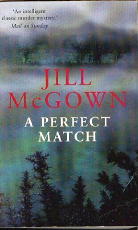
This is not, however, essential — the back-story is sketched in each time. That in itself is quite a challenge — finding new ways to explain the set-up to readers requires some ingenuity!
BIBLIOGRAPHY, as expanded from Crime Fiction IV, by Allen J. Hubin:
McGOWN, JILL (1947- 2007); see pseudonym Elizabeth Chaplin.
* A Perfect Match (n.) Macmillan 1983
* Redemption (n.) Macmillan 1988 [US title: Murder at the Old Vicarage]
* Death of a Dancer (n.) Macmillan 1989 [US title: Gone to Her Death]
* The Murders of Mrs. Austin and Mrs. Beale (n.) Macmillan 1991
* The Other Woman (n.) Macmillan 1992
* Murder Now and Then (n.) Macmillan 1993
* A Shred of Evidence (n.) Macmillan 1995
* Verdict Unsafe (n.) Macmillan 1997
* Picture of Innocence (n.) Macmillan 1998
* Plots and Errors (n.) Macmillan 1999
* Scene of the Crime (n.) Macmillan 2001
* Births, Deaths and Marriages (n.) Macmillan 2002. [US title: Death in the Family]
* Unlucky For Some (n.) Macmillan 2004
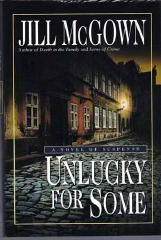
Standalones:
* Record of Sin (n.) Macmillan 1985
* An Evil Hour (n.) Macmillan 1986
* The Stalking Horse (n.) Macmillan 1987
* Murder Movie (n.) Macmillan 1990
CHAPLIN, ELIZABETH; pseudonym of Jill McGown

A Shred of Evidence was the basis of a TV movie entitled Lloyd & Hill, starring Michelle Collins as DI Judy Hill, and Philip Glenister as DCI Danny Lloyd. According to Ms McGown, it was for this film that Lloyd gained a first name.
[UPDATE] 04-15-07. For another tribute to Jill McGown, Jeff Pierce has one he posted earlier on The Rap Sheet. It’s excellently done, as usual, and one you should most definitely read.
Thu 12 Apr 2007
Movie Review: MURDER AT GLEN ATHOL (1936).
Posted by Steve under Mystery movies , Reviews[4] Comments
MURDER AT GLEN ATHOL. Invincible/Chesterfield, 1936. John Miljan, Irene Ware, Iris Adrian, Noel Madison, James Burtis. Based on the Doubleday Crime Club novel by Norman Lippincott. Director: Frank R. Stayer.
The date of the movie as given on the DVD case is 1932, but that’s in error. The book of the same title that the film is based on is 1935, a one-shot detective novel by Norman Lippincott, about whom very little is known. The book itself is scarce, with no copies being offered for sale by anyone on the Internet at the present time.
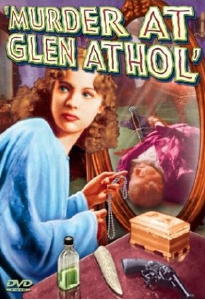
I happen to have a copy myself, but of course it’s inaccessible, along with most of my collection of Crime Club mysteries, shelved away in the far end of the basement, which I do intend to get to one day. Really soon now. So any impression of the mystery that Mr. Lippincott wrote is going to have to come from this filmed version instead, and I must say that I was impressed.
Within the 64 minutes that it takes to watch this tightly directed detective movie are all of the standard ingredients of the Golden Age mystery yarns of the time: A detective, Bill Holt, on holiday, played rather stiffly by John Miljan; his trusted and slightly comic assistant, Jeff (James Burtis) who looks like an ex-prizefighter; a brash and sexy vamp who lives next door, Muriel Randel (Iris Adrian), who’s not afraid of a little blackmail on the side, even if one of her victims is local gangster Gus Colletti (Noel Madison). See below.
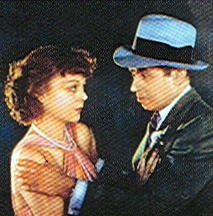
Visiting next door, where Holt is invited to a dinner party one evening is Jane Maxwell (Irene Ware), who in this movie is merely wholesomely pretty, not beautiful. Holt’s eye lights up as soon as he sees her; Muriel’s overt charms mean nothing in comparison. Jane Maxwell has her own secrets, but no one this wholesomely pretty could be guilty.
And Muriel is one of three people who are murdered later that same evening. I haven’t mentioned the other two, but suffice it to say that one of them is assumed to have killed both Muriel and the other victim, which suits the local police just fine. They’re wrong, of course, and the job Bill Holt takes upon himself is to prove it, and it isn’t easy, what with all of the red herrings, lies and false trails he’s forced to dodge and make his way down before doubling back.
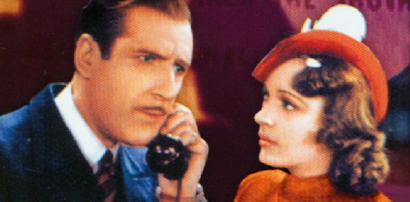
Movies like this are often played for laughs as well as for the detective aspects, but thankfully such small hilarities are kept to a minimum. It’s only a guess, but I’d have to say that the movie stuck fairly well to the novel it was based on. Whether that’s so or not, and low budget or not, this is detective movie that’s both worthy of the name and the just over sixty minutes that’s needed to take it all in.
PostScript: Here are the two leading ladies of this film, neither of whom are dressed as they are in this movie, but as if this blog weren’t classy enough, they do add a little something to the overall ambience, don’t they?
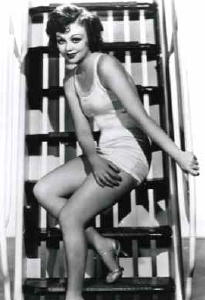
Iris Adrian
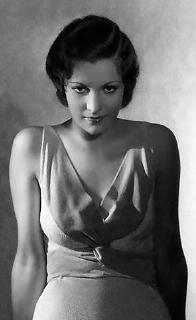
Irene Ware